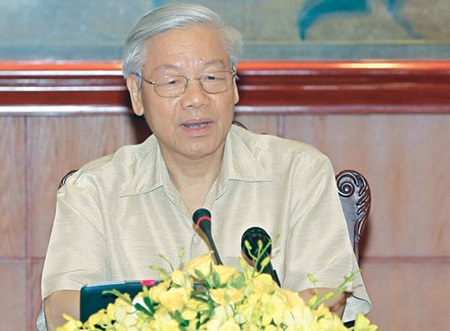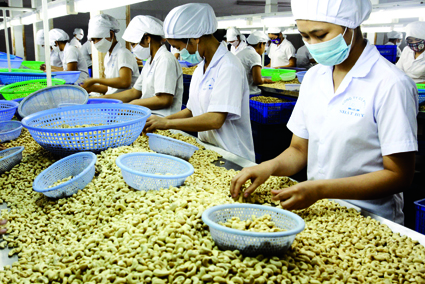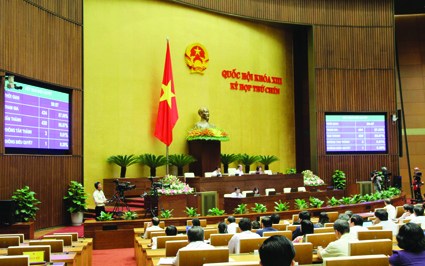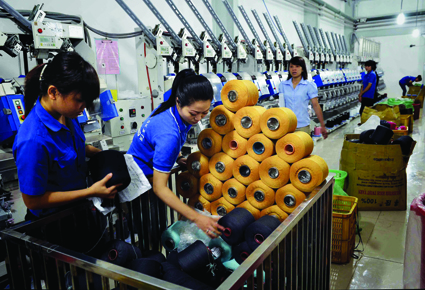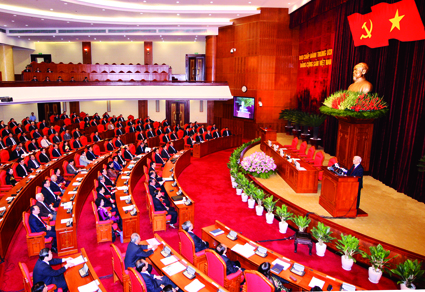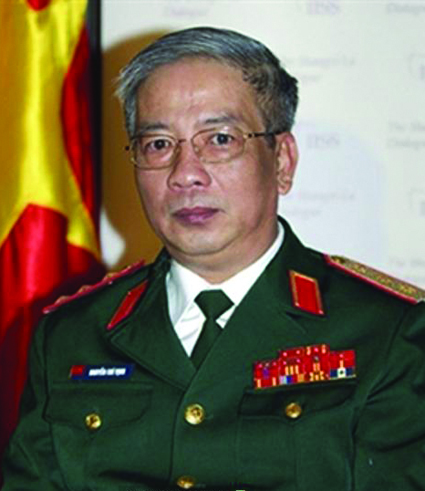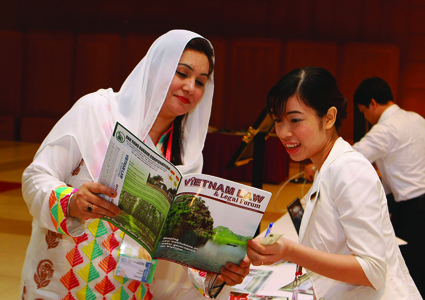Nguyen Van Giau
Chairman of the National Assembly’s Economic Committee
An overview of the agricultural and rural industrialization and modernization process
Agriculture has grown at a relatively high rate with increased productivity, quality and efficiency.
Over nearly 30 years of doi moi (renewal), Vietnam’s agriculture has recorded a rapid and stable growth rate in cultivation, animal husbandry, forestry and fisheries. The agricultural, forest and fisheries production value in 1986, 2005 and 2014 reached VND 65.1 trillion, 182 trillion and around 830 trillion, respectively. In 2014, agriculture, forestry and fisheries represented 0.61 percent in the growth rate of the country’s gross domestic product (5.98 percent against 2013). The sector’s export turnover had rocketed up from a mere USD 400 million in 1986 to USD 12 billion in 2007 and USD 30.86 billion in 2014. Some commodities, such as rice, coffee, rubber, cashew nut, pepper, wood and wood articles, and seafood, have been named among the world’s top exports.
Agriculture has been restructured toward large-scale commodity production closely linked with processing industry and market.
Linkages between farm-produce production and sale have been fostered and diversified to accord with production conditions in each region and locality. Examples of successful models include large-scale rice fields; farm-produce production, trade, processing and distribution chains; new-model cooperatives; hi-tech agricultural enterprises; and community-based agricultural service cooperatives and joint-stock companies. These models have opened up new avenues for the country’s agricultural development. Through production and sale cooperation, farmers and enterprises have played a key role in the farm produce value chain. The emergence of producer-seller farmers’ organizations has helped form stable and sustainable farming zones and build up brand names for farm produce to meet the market demand in the period of integration. Production relationships have been developed in a more suitable manner to involve different economic sectors in agriculture. So far, up to 24,000 farms have been registered according to new criteria.[1]
By the end of 2014, agriculture and rural economy had been restructured toward boosting the production of agricultural products with high market demands and economic value. In 2014, the paddy output reached a record level of 45 million tons, up by nearly one million tons than 2013. Livestock and poultry breeding prospered with higher yields of major products like meat, milk and eggs and the emergence of many industrial-scale hi-tech breeding farms.
The fisheries production value in 2014 rose by 6.8% against 2013. The value, quality and efficiency of offshore fishing improved thanks to the application of advanced technologies. The aquaculture output reached 3.4 million tons in 2014, up 6.1 percent against the previous year. Afforestation was stepped up, maintaining the forest coverage at 41.5 percent and increasing the forest output value by 7.1 percent. The planting of large-timber forests was initiated. Agricultural, forest and aquatic product processing industries continued to thrive with the formation of many new high-tech processing facilities. There are now 2,790 craft villages nationwide, including 240 traditional ones, which create regular and irregular jobs for around 11 million people.
Socio-economic infrastructure has been built in rural areas, and scientific and technological advances have been applied in different stages of agricultural production for higher productivity, quality, efficiency and competitiveness of agricultural commodities.
Many irrigation works have been constructed and put to use. All dikes, roads and fishing infrastructure facilities have been reinforced. More marketplaces have been built, renovated and upgraded, resulting in an increased value of goods and services traded, making significant contributions to the sale of agricultural commodities, promotion of production and improvement of people’s lives.
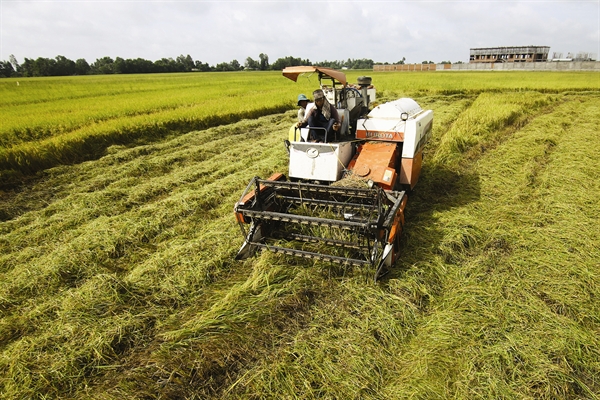 |
| Harvesting summer-autumn rice crop in Vi Thuy district, Hau Giang province __Photo: Duy Khuong/VNA |
Application of science and technology in agricultural production has become more popular with the use of new breeds and varieties, biotechnology and advanced methods of cultivation. In addition to the mechanization of agricultural production stages like watering, harvesting and cleaning agricultural products, processing animal feeds and aquaculture, advanced technologies have been applied to the preliminary processing and preservation of agricultural, forest and aquatic products, helping prolong the shelf life of food products while retaining their nutritional value.
Agricultural and rural industrialization and modernization have contributed to improving farmers’ material and spiritual lives.
Farmers’ lives and rural economy have seen significant improvements. From a country that used to import millions of tons of food, Vietnam has become the third largest rice exporter in the world (after India and Thailand). The rural poverty rate has dropped 1.8 percent per year; and farmers’ cultural, scientific and technical levels have markedly improved. Health care, education universalization and culture-information activities have been further stepped up. In rural areas, the political system has been strengthened; the peasantry’s position has been heightened; and political security and social order and safety has been maintained.
The new-countryside building program has reaped encouraging initial results thanks to the great efforts of Party committees and local governments at all levels and the enthusiastic response of the people. By January this year, 785 communes, or 8.8 percent of communes nationwide, had satisfied new-countryside criteria.
Difficulties and limitations
A number of legal documents have not been issued, amended and supplemented in time, causing problems to the development of the agricultural sector. Policies to tackle environmental pollution, climate change, sea level rise and salinity intrusion remain uncoordinated and incomplete.
Agricultural production and rural economy are slow to be restructured in many localities; the development of rural trades and services fails to match their potential; rural labor is basically farming.
The productivity, quality and competitiveness of a number of agricultural products remain low. Scientific and technological research and application as well as investment in agriculture remain limited.
Resources allocated for agriculture, farmers and rural areas fail to meet demands. Planning work remains unreasonable, uncoordinated and inconsistent and still fails to take into account implementation resources.
The development of different economic sectors in agriculture is still limited. Private enterprises, which play an important role in the rural economic development and labor restructuring, are still small, mainly engage in service activities and only thrive in suburban areas or areas with rather developed infrastructure.
The new models of production organization such as large rice fields, farm-produce production, trade and distribution chains, new-model agricultural cooperatives, hi-tech agricultural businesses, and farmers’ contribution of land use rights as shares to joint-stock companies, though assessed as new positive factors, still face not a few challenges. For example, the association between enterprises and people still lacks firm legal foundations; the viewpoint on land accumulation and concentration remains unclear; specific mechanisms and policies are not yet in place to assist enterprises in training their technical staff; agricultural production remains small-scaled; agricultural products are poorly competitive due to low quality and high prices; cooperatives still meet difficulties in access to the State’s incentive policies on credit, infrastructure investment, land; local governments in some areas have not fulfilled their responsibilities; and the wide application of the models is difficult due to lack of funds, techniques and human resources.
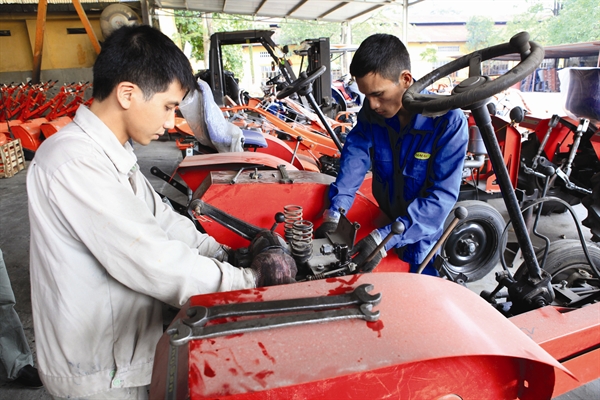 |
| Manufacturing agricultural machinery at the Tractor and Agricultural Machinery Company Limited (Ha Dong district, Hanoi), a member of the Vietnam Engine and Agricultural Machinery Corporation __Photo: Tran Viet/VNA |
For faster and more sustainable agricultural and rural industrialization and modernization
Besides the Resolution of the Xth Party Central Committee’s 7th plenum on agriculture, farmers and rural areas, it is important to thoroughly grasp other relevant documents like the Resolution of the IXth Party Central Committee’s 5th plenum on cooperative economy and the Resolution of the XIth National Party Congress on renewing the growth model associated with economic restructuring. The Politburo Conclusion No. 97-KL/TW of May 9, 2014, on a number of policies and solutions to implement the Resolution of the Xth Party Central Committee’s 7th plenum, clearly points out that agriculture, farmers and rural areas play a strategic role in the cause of national construction and defense. The goal of agricultural and rural development is to increasingly improve farmers’ material and spiritual lives based on agricultural and rural industrialization and modernization. Agricultural production should be regarded as a key task while building a new countryside as a fundamental one and farmers as main players in agricultural and rural industrialization and modernization. Agriculture should be comprehensively developed toward modernity, sustainability and large commodity production on the basis of sectoral and product restructuring in association with renewing the growth model and raising the competitiveness of agricultural products. It is necessary to enhance the role of farmers as masters while attaching importance to building and developing the peasantry.
Agricultural restructuring is part of restructuring the national economy along the line of ensuring growth quality and raising efficiency and competitiveness. Agriculture should be restructured in tune with the market mechanism while ensuring basic welfare for farmers and consumers, strongly switching from quantity-driven extensive development to improvement of quality and efficiency expressed in value and profit while attaching importance to satisfying social requirements.
We need to persistently pursue the objectives of the program on building a new countryside with incrementally modernized socio-economic infrastructure and a rational economic structure and appropriate production forms, combining agriculture with rapid development of industries and services for constantly improving people’s material and spiritual lives.
The development of new-model cooperatives cannot succeed without the Party’s comprehensive leadership and the State’s management. The Politburo Conclusion No. 56-KL/TW of February 21, 2013, clearly states that one of the solutions for developing collective economy is to effectively implement the 2012 Law on Cooperatives and improve mechanisms and policies to support the development of collective economy.
In the coming time, it is necessary to focus on implementing a number of the following main solutions:
Further reviewing and improving policies and laws concerning agriculture: The Law on Fisheries needs to be revised to complete regulations on aquaculture planning; add regulations on seafood processors, regulations on the vertical linkage among seafood producers, processors and exporters to enable traceability to ensure related parties’ interests; and regulations on the import of aquatic produce and the management of imported seafood quality. A Law on Irrigation should be enacted to replace the Ordinance on Exploitation and Protection of Irrigation Works, adding new regulations to create a legal corridor for the operation and development of enterprises exploiting and protecting irrigation works and for strengthening the state management in this area. In the meantime, agricultural insurance policies should be reviewed for the early issuance of a Law on Agricultural Insurance to insure farmers’ investment and agricultural production activities.
Raising the quality of planning and planning management: It is necessary to review, adjust and supplement agricultural production (cultivation, breeding and aquaculture) master plans in light of bringing into play the advantages of products, regions and areas. The use of agricultural land and land already zoned off for strategic farm produce and major exports, animal husbandry and aquaculture should be strictly controlled according to planning. The agricultural sector should be restructured along the line of associating production with processing and market, expanding on a reasonable scale production of advantageous farm exports and import substitutes, and developing industrial and semi-industrial animal husbandry and large-scale animal feed production to serve the domestic breeding demand. Linkages between breeding establishments and households and processors should be enhanced.
Supporting product consumption and market development: The domestic market should be restructured by expanding wholesale and retail networks and focusing more on developing remote, deep-lying and ethnic minority markets toward encouraging the development of social enterprises and ensuring the interests of direct producers. For export markets, it is necessary to maintain traditional markets, develop new markets, build brand names, improve quality and reduce costs to increase competitiveness of products. Efforts should be made to survey consumption markets to grasp consumer tastes, products, prices and trading customs. Market analysis, research and forecast experts should be developed to effectively assist policymakers. Commodity associations should play a more active role in the provision of information and uniform implementation of production development strategies and alignment in business and contract negotiation and conclusion.
Applying science and technology: Scientific and technological research and application in production, especially science and technology transfer, should be promoted so as to raise the quality of animal breeds and plant varieties and increase the productivity, quality, efficiency and competitiveness of farm products. Of no less importance are the application of biotechnology, building of hi-tech agricultural zones and increase of the disease resistance for plants and animals. Incentives should be given to enterprises and cooperatives investing in developing agro-forestry and fisheries processing and preserving technologies.
Developing association models: The sector should also review, renovate and build efficient economic models and forms of production organization in rural areas. Policies should be adopted to encourage the development of linkages between farmer households and enterprises, cooperatives, scientific organizations, commodity associations and consumption outlets with the aim of supporting the development of household economy on an appropriate scale and large-scale commodity production. Modern and professional production and business organizations should be established while developing types of economic cooperation and vertical linkage in agricultural production, processing and trading of farm products and linkage between agriculture and industry and urban economy.
Developing agricultural and rural infrastructure: Rural socio-economic infrastructural facilities need to be synchronously developed, focusing on expanding the irrigated acreage of subsidiary and industrial crops and ensuring water supply and drainage for areas under aquaculture and salt making. It is necessary to ensure year-round access to all communes and villages, build fishing ports, shelters for fishing vessels and other fisheries infrastructure; supply electricity to almost all rural residents, industrial establishments and services. Basic education, healthcare, cultural, sports and physical training services should be made available in almost all rural areas up to the level of average urban areas. Another important task is to build disaster prevention and mitigation capacity and reinforce the systems of river and sea dikes and coastal prevention forests, transport and irrigation works and residential infrastructure to weather storms, floods, salty water intrusion and sea level rise. Safe living conditions should be ensured for residents in the Mekong River delta and central regions and other flood- and disaster-prone areas while measures need to be actively taken to adapt and respond to global climate change.
Financial support policies: It is necessary to diversify funding sources to more strongly develop rural socio-economic infrastructure facilities. Priority should be given to financing the upgrade and building of synchronous irrigation systems in association with the renovation and raising of management efficiency to ensure water safety. Funds should be concentrated on strengthening reservoirs, dikes, and river and sea dams; upgrading warning systems for proactive prevention and control of storms and flooding, mitigation of disasters and protection of water environment. More investment should be made in rural roads to ensure all communes have car-accessible roads to their centers and gradually build car-accessible roads to villages. All rural residents should have access to electricity and clean water. Furthermore, medium- and long-term soft loans should be provided for enterprises participating in the enterprise-farmer cooperation model. The setting up of a fund to support farmers in production and post-harvest technology (first of all for paddy cultivation) to prevent post-harvest losses should be studied.
Human resources training and development: Preferential treatment policies should be adopted to attract hi-tech scientists as well as young professionals to work in agriculture and rural areas. Importance should be attached to training of new-countryside building program staffs, especially those at the grassroots level. In the meantime, vocational training should be organized to meet local development requirements as well as laborers’ needs, particularly in remote, deep-lying and mountainous regions with difficult socio-economic conditions.-
